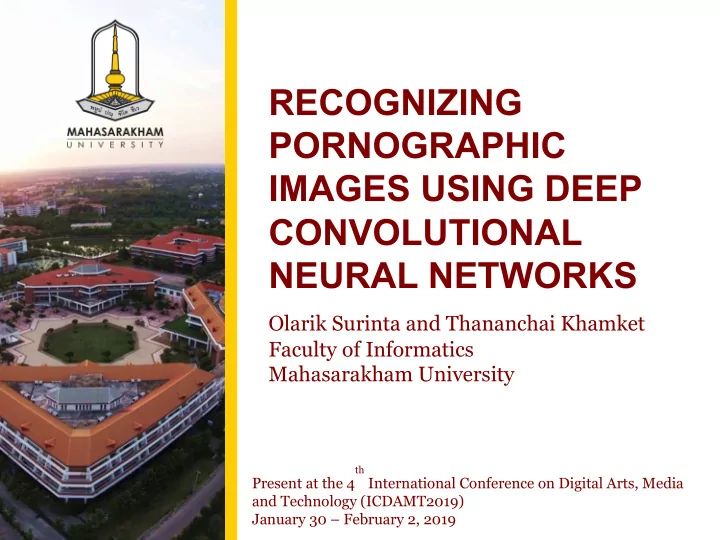

RECOGNIZING PORNOGRAPHIC IMAGES USING DEEP CONVOLUTIONAL NEURAL NETWORKS Olarik Surinta and Thananchai Khamket Faculty of Informatics Mahasarakham University th Present at the 4 International Conference on Digital Arts, Media and Technology (ICDAMT2019) January 30 – February 2, 2019
Outline: l Introduction l Pornographic image recognition methods l Experimental settings and results l Conclusion 2
Introduction: l In pornographic image recognition , image processing and machine learning techniques are proposed to use. l Due to the image processing techniques , l the human skin is extracted from the whole image. l The RGB is converted into HSV and YCbCr color spaces to extract the skin color. l The whole image region is calculated and decided as the pornographic image when the ratio is more than the threshold value . 3
Introduction: l For the machine learning technique , l First, the color image is converted into HSV, YCbCr color space to extract skin area . l Then, extracted the feature from the skin area. l Finally, the machine learning technique such as SVM and MLP are used to create a model and classify. 4
Introduction: l Rattanee and Chiracharit (2016) Nudity detection based on face color and body morphology 5
Introduction: l Wijaya, et al. (2015) Pornographic image recognition based on skin probability and Eiganporn of skin ROIs images 6
Introduction: l Wijaya, et al. (2015) Phonographic image recognition using fusion of scale invariant descriptor 7
Introduction: l We evaluate the performance of 16 different techniques on a TI-UNRAM pornographic image dataset . l The use of existing deep CNN architectures (ResNet, GoogLeNet, and AlexNet) and a BOW method are presented. l This paper is combining three well-known local descriptor methods , called LBP, HOG, and SIFT and three machine learning technique ( SVM, MLP, and KNN ). 8
Pornographic image recognition methods: l Deep Residual Networks (ResNet) l ResNet architecture has very deep network and shown good performance in many image recognition. l He et al. proposed the deep ResNet architecture with a depth of 18, 34, 50, 101, and 152 layers. l The ResNet-152 is deeper 22 and 7 times than AlexNet and GoogLeNet, respectively. 9
Pornographic image recognition methods: l The novel architecture called shortcut connections , is proposed. l The shortcut directly uses the input of the previous layer to the next output. 10 Residual network Plain network
Experimental settings and results: l The TI-UNRAM pornographic image dataset l Experimental setup l Experimental results 11
TI-UNRAM dataset: l This dataset includes two classes and contains 685 pornographic, 715 non-pornographic images ( 1400 images ) l These images are collected from the Internet l We randomly divided 50% of the whole dataset into training and test set 12
Non-pornographic images: 13
Complex images: Can you guess which images are pornographic? 14
Experimental setup: l We use 2-fold cross validation according to Wijaya et al. (2015a, 2015b). l We compute the average and standard deviation for evaluating the test performance of l deep CNN architectures l Local descriptors combined with machine learning techniques l bag of words (BOW) 15
Experimental results: Recognition results using deep CNN methods 16
Experimental results: Recognition results using different local descriptors and machine learning techniques 17
Conclusion: l We have presented a comparative study on the TI-UNRAM pornographic image dataset including l local descriptors combined with machine learning techniques l a bag of visual words (BOW) l deep convolutional neural networks (CNNs) 18
Conclusion: l First , we proposed to use the LBP, HOG, and SIFT as for the local descriptor methods. l These three descriptor methods combined with 3 machine learning techniques; l SVM, MLP, and KNN l The results show that the LBP+SVM outperforms the other combinations. l The LBP+SVM method also gives a better result than the BOW method. 19
Conclusion: l Second , we compared three deep CNN architectures l ResNet, GoogLeNet, and AlexNet architectures l To make a fair comparison, in these experiments, the transfer learning and the data augmentation are not performed . l The results show that the best recognition accuracy is the ResNet , GoogLeNet, and AlexNet, respectively. 20
Conclusion: l Finally , the ResNet architecture which is the best result in our experiment , also slightly higher than the LBP+SVM . l Future work: l We want to improve the result of the deep CNN by using transfer learning and data augmentation. l We also consider the deep learning approach that requires less memory usage and a decrease in training computing time. 21
ICDAMT2019: l Thank you for your kind attention. 22
Recommend
More recommend